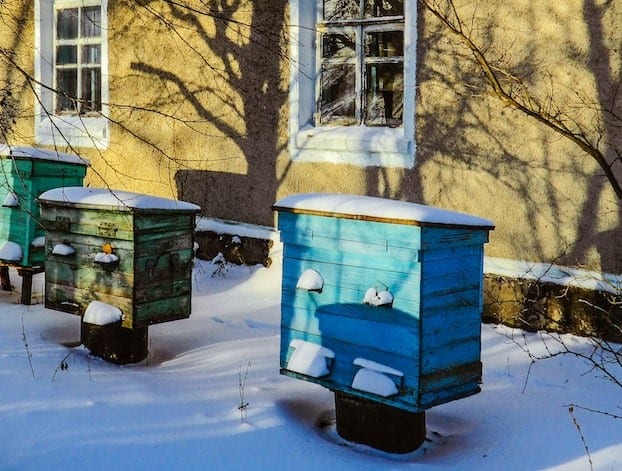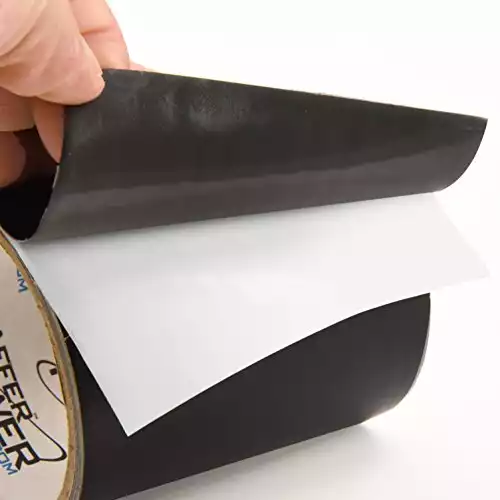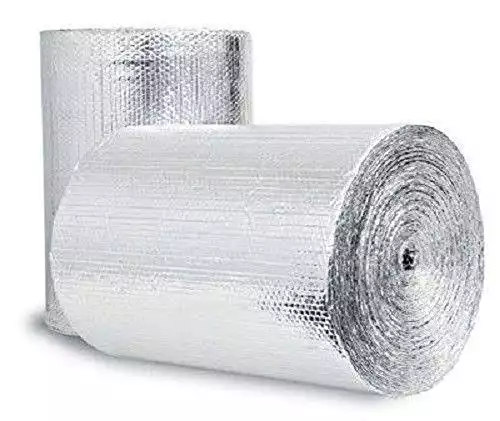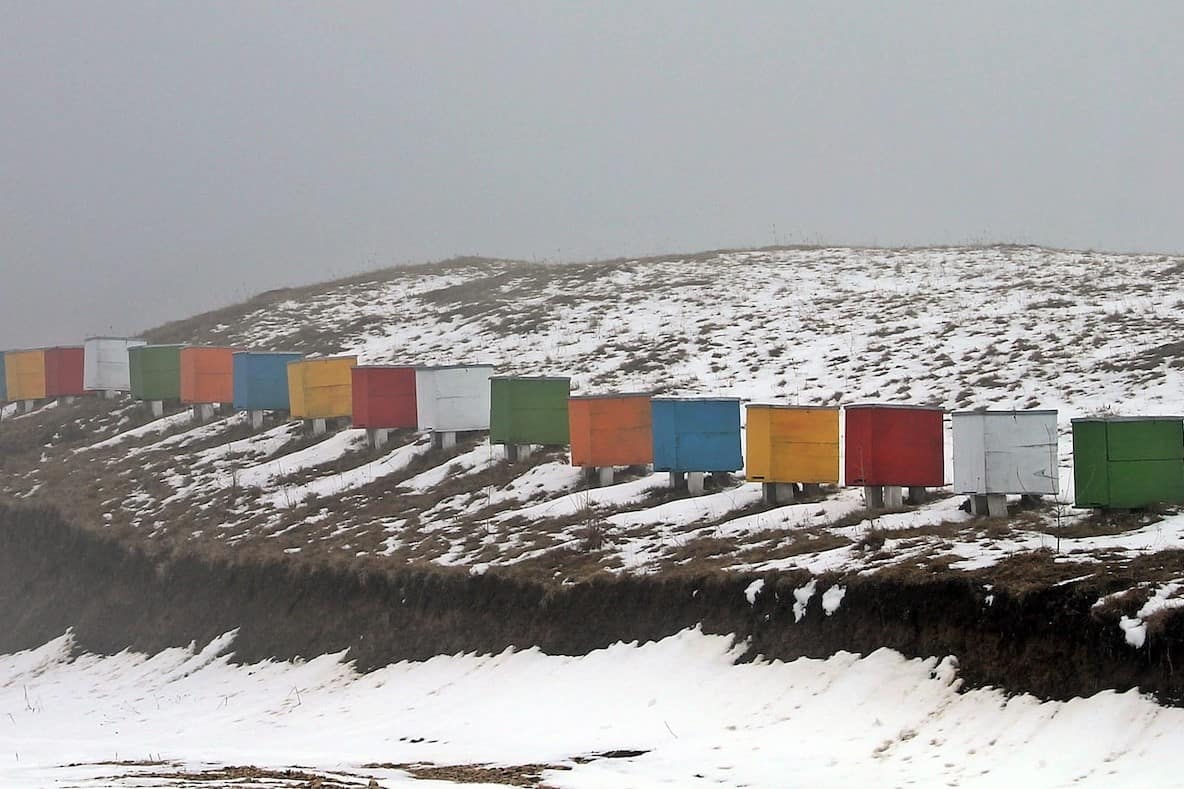We have written about preparing for winter already, but in this post, we double down on how to wrap bee hives (beekeeping insulation) for the winter.
Even though wrapping hives does not guarantee a colony’s survival, it makes a difference. Between April 2020 and April 2021, the average colony loss in the United States was 45.5%.
With alarming stats like that, we have a responsibility to do whatever we can to give our bees the best possible chance of survival.
Beekeeping insulation for the winter guarantees your bee colonies’ survival.
Why Should You Wrap Your Hive?

Although honeybees are not native to the U.S., they have been around long enough to acclimatize to their surroundings.
We still have wild bees living in trees, yet we do not wrap trees up in the winter. So, why should you insulate your hives?
Preparation for Winter Cluster
A study on feral colonies in Colorado highlights the sudden drastic drop in temperatures as the fatal blow to bees rather than the low temperature. If the temperature decreases slowly, bees have time to put their house in order.
Before they form a bee cluster, they need to consume honey, which provides the energy they need to shiver their wing muscles to warm up the winter colony. When the ambient temperature drops to 57°F, the bees form their spherical cluster surrounding the brood if the brood is present. As the temperature drops a few degrees further, it is harder for bees to break away from the bee clusters to get to other frames of stored honey.
Prevent Colony Loss
In this study, the researchers highlight a drastic 65°F drop between 25th-27th October 2017. In 36 hours, they went from a high of 84.9°F to a low of 19.9°F. They believe that the sudden drop led to the loss of many colonies that year.
Prevent Heat Loss
If all bees still lived in trees, they would be better insulated. Your typical beehive is ¾ of an inch thick, whereas a hollow tree can provide 4-10 inches of wood around the nest, keeping heat inside the nest.
Researcher Derek Mitchell suggests that clustering, as we know it, is an adaptation to our beehives rather than an instinctive behavior. If a bee colony is sufficiently insulated, the drop in temperature would be gradual, giving the bees time to form a cluster and prevent or minimize heat loss.
Now you know why winter beehives require insulation. Let’s move on to what materials we use to wrap beehives.
What Can You Use to Wrap Your Beehive for Winter?
There are a few alternatives to wrapping the entire hive. An insulated hive prevents cold air from getting too fast into the bee hive. Good beehive insulation can protect your honey bee colonies during cold climates.
Here are some bee hive wraps you can purchase online when you winterize bee hives.
All Weather Patch Tape
$15.88 ($3.18 / Foot)
See on Amazon
We earn a commission if you make a purchase, at no additional cost to you.
04/25/2024 11:50 pm GMT

| PROS | CONS |
| Professional-grade sealing results – flexible butyl tape that solves any sealing problem. | It deteriorates over time – It will get your bee hive through the winter but may deteriorate over time. |
| Heavy-duty – designed with an extra-strong adhesive backing that sticks to any surface and holds up under extreme weather conditions. | |
| Water-proof – Effectively keeps water out of the bee hive. | |
| Lightweight and handy – It is easy to carry from one hive to another. | |
| Readily Available – Great for a quick cover-up of any bee hive. |
Corrugated Plastic Sheet
$59.99
See on Amazon
We earn a commission if you make a purchase, at no additional cost to you.
04/25/2024 10:54 pm GMT
(Recommended)

| PROS | CONS |
| Lightweight – A pack of 10 sheets, 24” x 36” weighs only 11 pounds. Sheets are available in a variety of sizes. | Requires minor construction – For procrastinators, which many of us are, you can’t just buy the sheet and put it on the hive. You will need to bend them into shape first. There’s a video in the how-to section of this post that will show you how to do it. |
| Weather resistant – Handles sunlight and rain for extended amounts, meaning you can reuse these sleeves for several years. | It’s a little hard to find – Since this is a specialized material, your local hardware store may not have it in stock. |
| Absorbs heat on sunny days – The sheets serve as insulation panels that absorb heat on those rare sunny days and help warm up the beehive, allowing the cluster to expand and keeping every bee cozy. |

| PROS | CONS |
| Affordable – A 10-foot roll of this reflective foil costs as low as $30. Prices will vary depending on the quality and length you buy. | Reflects the sunlight away from the hive – The reflective surface reflects the light and heat away from the hive, meaning the sun cannot heat the hive even on a sunny day, or heat cannot pass through during those warm winter days. When the temperature warms the surrounding air of the hive, heat transfer to the insides of the beehive is not possible. |
| Weather resistant – This insulating material can handle the exposure to sun, wind, and hail without much of a fuss, making it reusable the next year. | It only works well if you engineer a still air gap between the wrap and the hive body – If you can use some carpentry skill to attach an inch-thick shim on the outside of the hive and attach the foil wrap to that, on both the top and bottom. That inch of still air space would add the insulation effect. Without that air gap, the bubble wrap is less effective. |
| Light and malleable – As it comes in a roll, you only need to get it to the hives, wrap, cut, and staple/nail/tac it in place. |
Cotton Beehive Cover
$15.87
See on Amazon
We earn a commission if you make a purchase, at no additional cost to you.
04/24/2024 08:34 am GMT

| PROS | CONS |
| Biodegradable – Cotton is a renewable fiber. If you need to dispose of it, you know the environment will take it back. | Bulky – Storing this hive wrap for the next winter will take up room in your garage. |
| Easy to wrap using fastening straps – This outer cover is a lot easier to put on and take off than stapled wraps. | |
| Affordable – This hive cover is an effective insulation material that would not dent your pocket. |
When Should You Wrap Your Hive for the Winter?
Bees in the South get through the winter pretty well as long as they have enough honey stores. Those in the north deal have colder climates with sub-zero and cold temperatures for several days at a time. Often, cold snaps occur, causing a sudden drop in temperature. Those are the colonies that benefit from an insulated hive.
If you live in northern Colorado, for instance, you should consider winterizing your beehives and wrapping your beehives for winter. Beehives amidst freezing temperatures and without a hive wrap can cause the death of your honey bee colony.
If you choose to have a winter hive setup, wrap them up before the very cold temperature sets in to keep the hive warm and conserve heat.
The hive wrap will trap the warmer, moist air inside just as the bees create their cluster. If the temperatures drop suddenly, you do not want to be caught unprepared.
An infrared or thermal camera would be a handy tool to have. It allows you to see the location and size of the cluster without opening the hive.

When You Wrap Your Hive, Remember To:
Provide an allowance for an upper entrance for cleansing flights.
Many beekeepers argue the warm air from the cluster will escape through the upper entrance, but the opening is small and unlikely to chill the bees. In the wild, the hive’s entrance is rarely at the bottom of the tree, so the bees know how to navigate the upper entrance.
Bottom entrances also get blocked by dead bees; therefore, an upper entrance is a way to go.
Provide adequate insulation and ventilation above the cluster below the top cover.
Too much condensation within the hive can kill your bees. To absorb excess humidity and moisture from the cluster, use quilt boards.
A foam board above the quilt board will help retain some of the colony’s heat since it loses 75% of its heat through the top of the beehive.
Refrain from opening the beehive unless it is an emergency.
The wraps can only preserve the heat generated by the bees. The wrap does not generate heat, so you must keep that hive closed for as long as possible.
Once again, an infrared camera will be handy, showing you when the cluster has moved up and is right under the inner cover and hive entrance, signaling that they need food.
To Wrap or Not to Wrap Is up to You
Opponents of beehive insulation say that you risk getting your bees to live in a hive with relatively warmer, moist air.
The same warm, moist air would trick these honey bees into consuming large amounts of food before the spring. However, studies show that colonies in wrapped hives consumed less honey than their unwrapped counterparts.
The primary reason bees eat honey, aside from general sustenance, is to generate heat. The more heat they retain, the less heat they need to generate, meaning the less fuel they consume, in this case, honey.
Some beekeepers recommend wrapping, while others do not believe it makes a difference. However, we cannot deny the science.
Studies on beekeeping have shown that hive insulation can be beneficial during the winter days. Any type of hive can be wrapped, including top bar hives.
With all the challenges bees face, including increased exposure to pesticides and lower-quality food, is a little extra warmth too much to ask? I don’t think so.


Thank you for the intelligent explanation. First time having bees. All summer bees drinking water. Do bees thrirst in winter ? How do they get a drink?